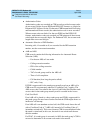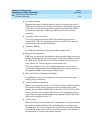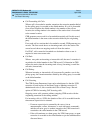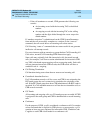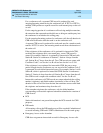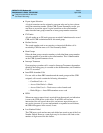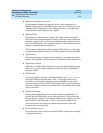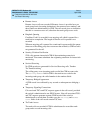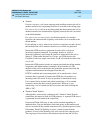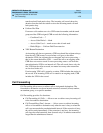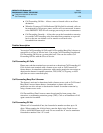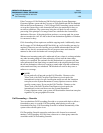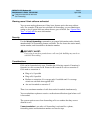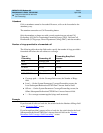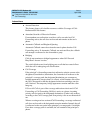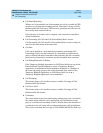
DEFINITY ECS Release 8.2
Administrator’s Guide
555-233-506
Issue 1
April 2000
Features and technical reference
1277Call Detail Recording
20
■ Transfer
If a user originates a call on an outgoing trunk and then transfers the call to
another extension, the originating extension is recorded as the calling party.
If a user receives a call on an incoming trunk and then transfers the call to
another extension, the extension that originally received the call is recorded
as the dialed number.
If a user receives an intraswitch call and then transfers it to another
extension, the extension that originally received the call is recorded as the
dialed number.
If call splitting is active, when a user receives or originates a trunk call and
then transfers the call to another extension, two records are generated.
Intraswitch CDR records are generated for each call to or from an
intraswitch optioned extension. For example, Station A, which is
intraswitch optioned, calls Station B. Station A then transfers the call to
Station C. When either Station B or C drops, two CDR records with
Condition Code 0 are output: one for the A to B call, and the second for the
A to C call.
Intraswitch CDR transfer records are output when both the calling number
(originator) and dialed number (terminator) drop from the call. The
duration of the call is from the time the terminator answers until both the
originator and terminator have dropped from the call.
If ITCS is enabled and an incoming trunk call is transferred to a local
extension that is optioned for Intraswitch CDR, the call produces an
incoming trunk call record. It does not produce an Intraswitch record.
Users cannot dial an account code when transferring a call to another
extension, unless they have console permissions. However, a user
transferring a call to a trunk can dial an account code before dialing the
ARS or TAC.
■ Trunk-to-Trunk Transfer
Although they are not really conference calls, Trunk-to-Trunk Transfer
connections are treated as such for CDR purposes. A separate CDR record
is generated for each trunk in the connection.
Unanswered Trunk Calls may or may not be recorded depending on
administration. You can administer each trunk group so that unanswered
calls are recorded if they remain unanswered for a specified period of time.
If Incoming Trunk Call Splitting is active, a trunk-to-trunk transfer
produces a record of the incoming call, and a record of the outgoing call.
The outgoing call record shows the duration from the time the call was



